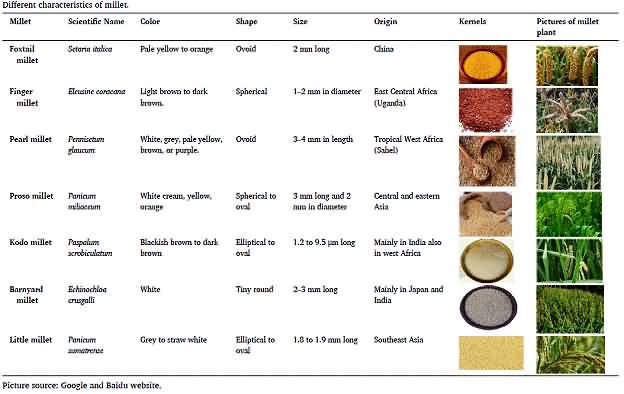स्मार्ट फ़ूड और स्मार्ट फ़सल के रूप में बाजरा
India celebrated the national year of millets in 2018. The U.N. General Assembly recently adopted a resolution, sponsored by India and supported by more than 70 countries, declaring 2023 as the International Year of Millets. The main objective of declaring this resolution is to increase public awareness about health benefits of millets and their suitability for cultivation under harsh conditions under changing climatic senerio.
Millet is a common term to categorize small-seeded and known for high nutritive value that are often termed nutri-cereals, and includes sorghum (jowar), pearl millet (Bajra), Finger millet (ragi ), small millet (Sama), foxtail millet, proso millet (Variga), barnyard millet, kodo millet and other millets.
Nowadays, there are many global issues like the rapid increase in population, global climate change, increasing food prices, water scarcity, environmental contamination, and other socio-economic impacts. These factors could adversely affecting regional agricultural developments and reduced grain production, resulting in high food prices and major food security issues worldwide.
Millets are also know as “poor man food” as it is easily available, highly nutritious, very cheap, especially for those who live in hot and dry areas. As per report of the World Bank, about 815 million people worldwide are facing the problem of hunger and malnutrition. This is one of the major issues mainly in developing countries as they are not getting enough food, and their food deficiency results in illnesses and deaths worldwide.
A specific attention to the nutritional quality and cultivation of millets can provide an overall solution to the existing challenges of hunger and malnutrition. Several studies have reported that millet consumption can be considered as supplement food for improving nutritional security and livelihoods worldwide. Millet consumption of can help to achieve the target of United Nations’ commitment to end malnutrition by 2030.
Millets as Smart Food
Millets are consumed worldwide, especially in hot and dry areas of Africa and Asia. High nutritive value of millets makes very suitable to agro-industry. Millets are of seven types having different colors, shapes, sizes, and cultivation areas. These grains are the oldest, and probably the first cereal grain, known to human for domestic use; they are small-seeded, round shape cereals and belong to the Poaceae family (FAO, 2020).
In India millets consumed in the form of khichdi, idli, and chapatti etc. India is the largest millet producer, followed by Niger, Sudan, and other countries, it can be estimated that over 96% of millet crops are planted in Africa and Asia because of their suitable agro-climatic conditions which support the growth and development of millet crop.
Millet can be used to produce several types of commercial foods for worldwide consumptions, such as puffed millet, millet juice, and millet noodles. In general millets contain protein (7–12%), fat (2–5%), carbohydrates (65–75%) and dietary fiber (15–20%). Among millets, pearl millet has more protein and free lipid, followed by proso millet, foxtail millet, and barnyard millet, respectively.
Millet has phenolic acid such as hydroxybenzoic acid (gentisic acid, vanillic acid, protocatechuic and syringic acid), hydroxycinnamic acid (p-coumaric acid, sinapic acid, ferulic acid, and cinnamic acid), and flavonoids (taxifolin, catechin, quercetin, and apigenin).
Bioactive compounds such as antioxidant and anti-microbial activities in millets can induce several potential health benefits. More attentions has been given for millet production and processing for its better utilization to mitigate hidden hunger in the world.
Scientific findings says that millets are cheaper and nutritionally superior to wheat & rice owing to their high protein, fibre, vitamins, rich in antioxidants and minerals like iron, calcium and magnesium content. For example, highest calcium content present in Ragi among all the food grains.
Millets can help in high prevalence of anaemia as it is rich in iron. Millets are gluten-free and have a low glycemic index which can help tackle lifestyle problems such as obesity and diabetes as they.
Millets as Smart Crop
Millets are probably only one cereal crop that can grow in hot and drier conditions, i.e., 64 ◦C temperature and 350–400 mm annual rainfall. This might be due to their efficient photosynthesis system as they are C4 cereals, and their seeds mature only in 6–8 weeks.
Millets are Photo-insensitive (do not require a specific photoperiod for flowering) & resilient to climate change. Millets can be grown on poor soils with very little or no external inputs.
Millets are less water consuming and are capable of growing under drought conditions, under non-irrigated conditions even in very low rainfall regimes Millets have low carbon and water footprint (rice plant needs at least 3 times more water to grow in comparison to millets).
Millets can withstand high temperature, low soil moisture or other harsh conditions and, thus, are a good risk management strategy for resource poor marginal farmers.
Different characteristic and detail nutritional profile of millets:

References
Yousaf, L., Hou, D., Liaqat, H. and Shen, Q., 2021. Millet: A review of its nutritional and functional changes during processing. Food Research International, 142, p.110197.
Authors
1Shailesh Kumar and 2Sweta Mishra
1Assistant Professor, Department of Botany,
Plant Physiology and Biochemistry, CBS&H, Dr. Rajendra Prasad Central Agricultural University, Pusa, Samastipur, Bihar-848125
2Professor, Department of Plant Breeding & Genetics,
PGCA, Dr. Rajendra Prasad Central Agricultural University, Pusa, Samastipur, Bihar-848125
